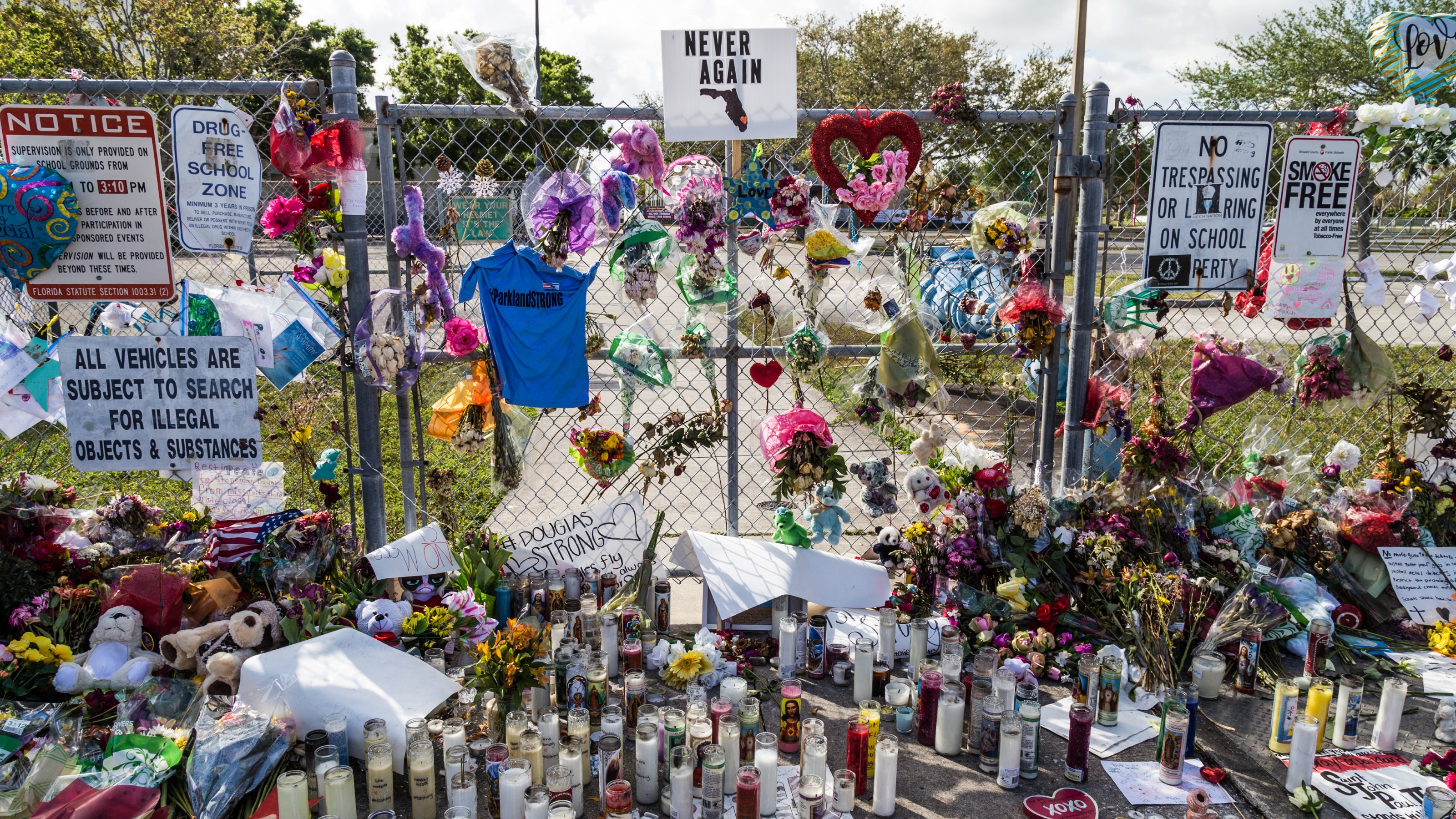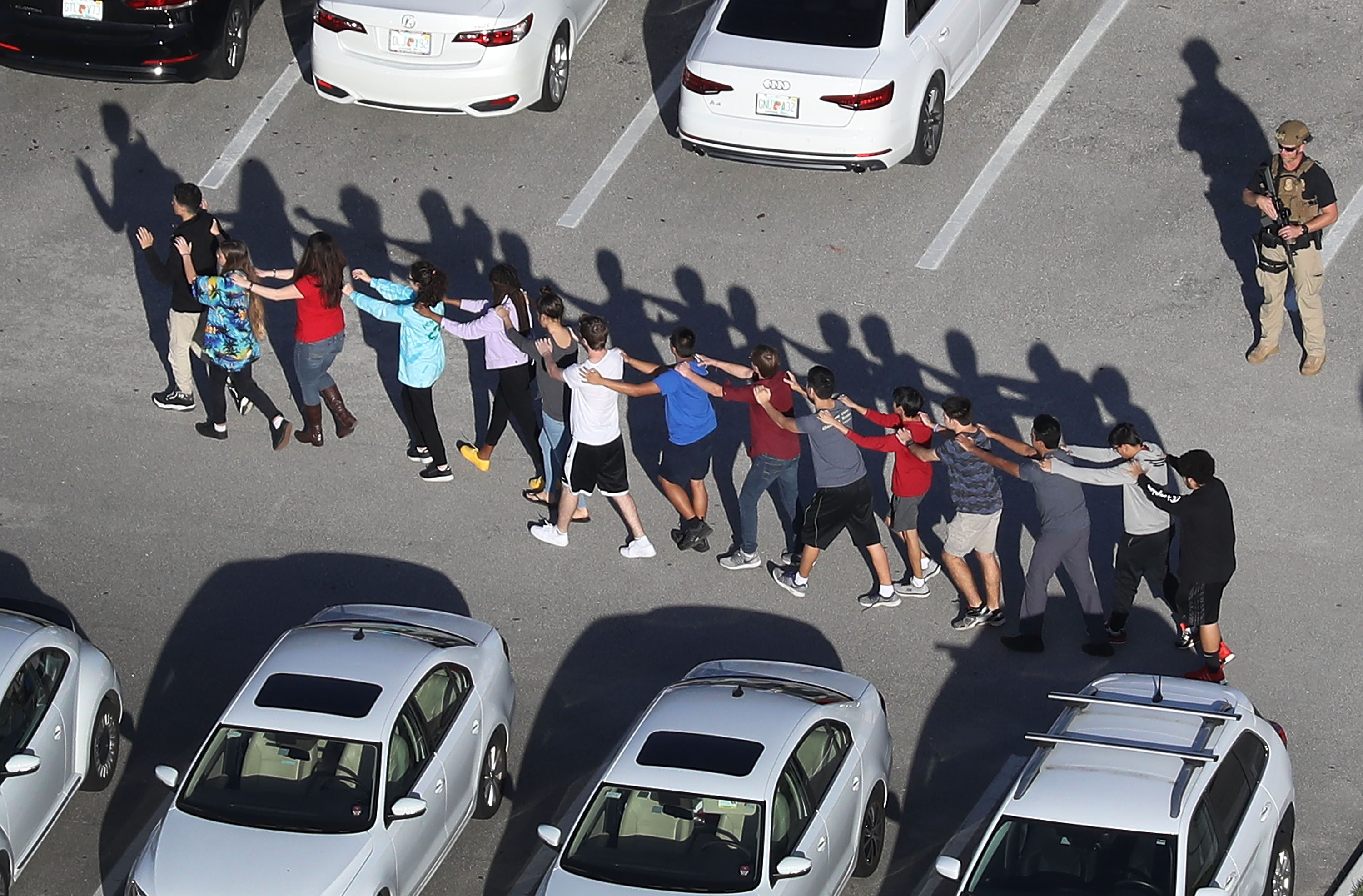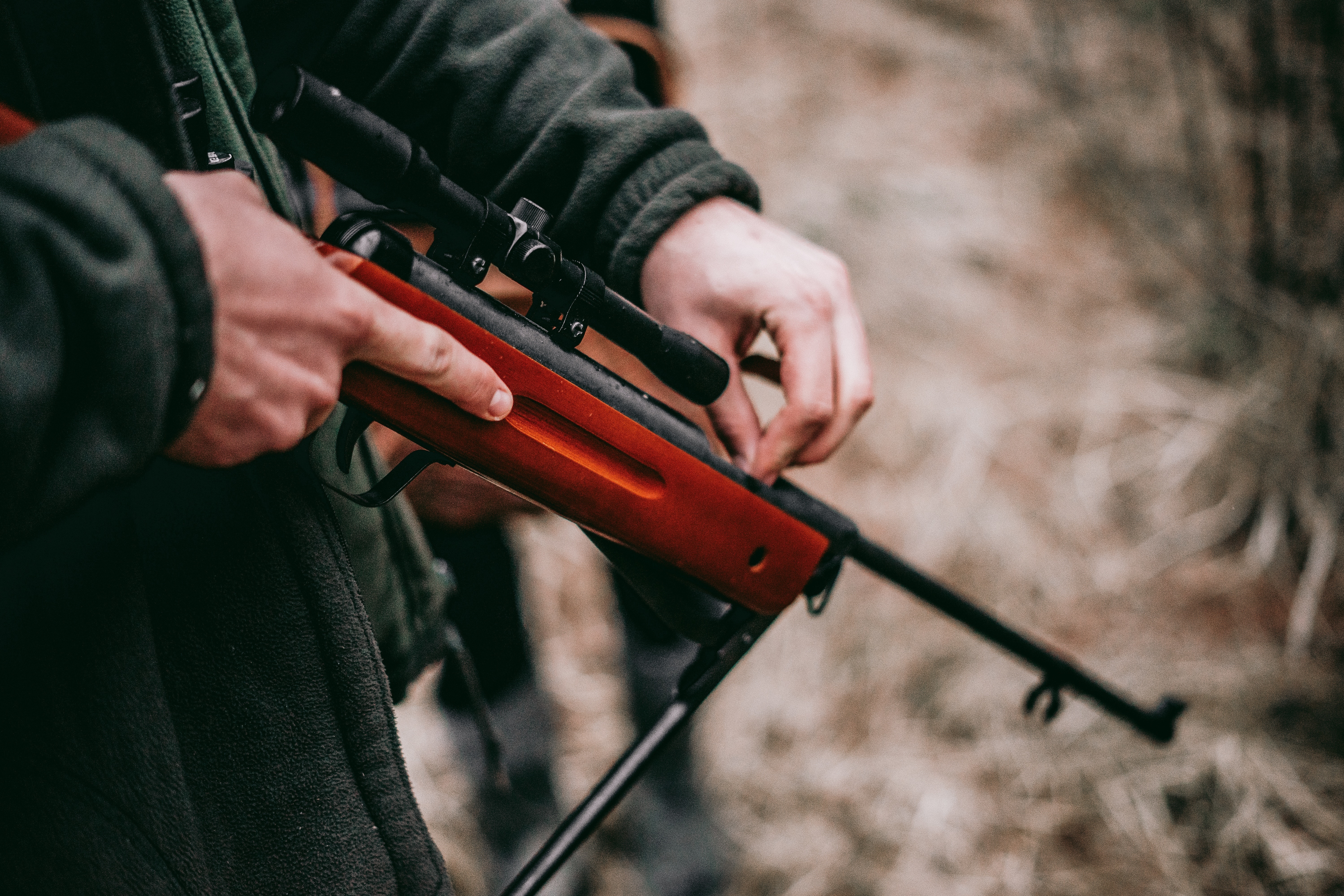The 4 risk factors behind someone becoming a mass shooter

- The Violence Project is a nonprofit, nonpartisan think thank that has compiled the most comprehensive database on mass shootings in the U.S.
- The think thank’s founders, James Densley and Jillian Peterson, authored the book The Violence Project: How to Stop a Mass Shooting Epidemic.
- This excerpt from the book explores four key factors that are highly correlated to mass shootings in the U.S.
Excerpted from the book The Violence Project: How to Stop a Mass Shooting Epidemic by James Densley and Jillian Peterson published by Abrams Press ©2021.
Monsters
Nearly six hours into the interrogation video of the Parkland shooter, there is a moment: The teenage boy has just confessed to killing seventeen people at his former high school. He sits slumped in a chair, barefoot, hands cuffed behind his back, one leg shackled to the floor. He’s dressed in a pale blue hospital gown that billows open in the back whenever he leans forward, revealing a frame so slight that it seems impossible it could even hold a semiautomatic rifle, let alone use one to wreak the kind of terror this town has just witnessed.
“What do you think Mom would think right now if she was…?” his younger brother asks. The police have permitted him into the interrogation room, hoping he might solicit a motive. His brother can’t finish the sentence. Their mother, who adopted the boys as children from the same birth mother, died of pneumonia just three months ago.
“She would cry,” both boys agree unanimously.
“People think you’re a monster now,” the brother says.
“A monster?” The shooter starts to shake.
“You’re not acting like yourself,” the brother goes on. “Why? Like we’ve—this is not who you are. Like, come on. Why did you do this?”
The perpetrator starts to cry. “I’m sorry,” he whispers.
“I know what you did today,” the brother continues. “Other people look at me like I’m crazy for even—and I don’t, I don’t care what other people think. Like, you’re my brother. I love you. I want—I want you to—”
The shooter completely breaks down. There is a prolonged high-pitched cry before his body collapses in violent sobs.
The brother puts his head in his hands, then slams his hand on the table. He turns to the detective off- camera. “Can I hug him?”
The perpetrator, hysterical now, leans in. The brother quickly stands, walks over to his wailing sibling, and wraps him up in both arms.
It’s instinct to cast aside mass shooters as monsters—their destruction is horrific and beyond comprehension. Collectively, they have claimed thousands of innocent lives and destroyed many more. Mass shootings are senseless, and they terrorize so deeply because they are so unpredictable, so inhuman.
That’s why our societal response to mass shootings has been to wage war on the monsters. We’ve tried locking the monsters out. We’ve turned our schools into secure fortresses with metal detectors, bulletproof windows and impenetrable doors. We’ve installed high-tech security systems in our workplaces, even stationed police outside our concerts and casinos to spot the monsters before they get in.
We’ve tried running from the monsters. Teachers time their students as they race through hallways single file to designated meeting spots where frantic parents will wait. We scan for exit points at the movie theater and sit in a seat on the aisle so we can be the first ones out the door.
We’ve tried hiding from the monsters. Hushed children huddle in fear in dark supply closets or hide behind bulletproof backpacks. Text messages alert employees to “shelter in place.” Our workplace drills test how quickly we can stack chairs, dive under our desks, or crouch inside cabinets.
And we’ve even tried fighting the monsters. We’ve turned off the lights and practiced throwing our makeshift weapons— chairs, sharpened pencils, staplers, textbooks, binders, canned goods. We’ve named and shamed them on national television. We’ve hired good guys with guns to protect us from them.
America has been hunting monsters—even though they were among us before this—for more than two decades, ever since two high school seniors from Littleton, Colorado, murdered twelve students and one teacher before dying by suicide in what, at the time, was the worst high school shooting in U.S. history. Since that fateful day in April%1999, we’ve spent countless hours and billions of taxpayer dollars drilling, training, and preparing.
And still we are losing. The monsters aren’t going away. In fact, there are more and more of them. And they are killing more and more people with each passing year. All the running, hiding, and fighting has failed.
It has failed because the monsters are not them. They are us—boys and men we know. Our children. Our students. Our colleagues. Our community. They’re walking in and out of the same secure doors we are, past the same armed guards every day, like the rest of us. They’re standing next to us when we rehearse for the next shooting. They’re reading and watching the same media stories we are. They are not outsiders. They are insiders.
This fact may make mass shooters seem harder to stop. The reality is quite the opposite: It means we know where to find them, and with our research, we have learned how to reach them before they ever pick up a gun.
—
The first letter we received from Perpetrator A was brief. It was written neatly in impeccable cursive on yellow legal paper.
Greetings.
I received your letter today & would like to thank you for offering me the opportunity to participate in this study. It will be an honor to provide you whatever input/assistance I am able to contribute to your research.
A few weeks later, Jill answered Perpetrator A’s first call from a maximum-security prison. We had no control over when our perpetrator research participants were able to call us, so we had to be ready to answer their collect calls at any moment. If we missed a call, it could be days before they could call again. We set up our research line to run through Jill’s cell phone when we weren’t at work. This time Jill was at home with her three kids, so she stepped out on the back porch to take the call.
Perpetrator A was polite, formal, nervous—his Southern drawl was a little shaky: “So…this is a study about mass shooters?”
“That’s right. We’re studying the life histories of mass shooters, everything leading up to your crime,” Jill began.
“What makes people like me do such awful things?” Perpetrator A asked. “Sounds like a pretty important study. It sure seems like it’s happening a lot more often these days, doesn’t it?”
Perpetrator A has now spent twenty-five years, more than half his life, locked up for killing four people and wounding seven others in a late-night restaurant shooting rampage, and in that time, mass shootings have only grown in number and severity.
—
Perpetrator B’s first letter to us was formal, gracious, written in shaky block letters:
I RECEIVED YOUR LETTER, AND I THANK YOU FOR TAKING THE TIME TO WRITE ME. I HAVE CONSIDERED YOUR REQUEST AND HAVE DECIDED THAT I AM INTERESTED IN BEING A PART OF THE WORK YOU ARE DOING TO PREVENT VIOLENCE FROM HAPPENING IN THE FUTURE. I WISH YOU THE BEST DURING THIS HOLIDAY SEASON AND THANK YOU AGAIN FOR CONTACTING ME. I WILL LOOK FORWARD TO YOUR RESPONSE. GOD BLESS YOU!
Throughout this book, we will show our interactions with mass shooters like Perpetrator A and Perpetrator B in their own words, alongside those of many others throughout this book. Their stories help us question and challenge some common misconceptions about mass shootings and the policies that have followed. As we’ve synthesized our work, we have found that there are patterns in the lives of mass shooters that we see again and again. Understanding these patterns is, we feel, the key to unlocking solutions.
First, many mass shooters experience childhood abuse and exposure to violence at a young age, often at the hands of their parents. Parental suicide is common, as is physical abuse, sexual abuse, domestic violence in the home, and severe bullying by classmates. This early exposure to violence and unaddressed trauma feeds the perpetrator’s rage and despair later in life. Mental health concerns such as depression, anxiety, and paranoia commonly develop during adolescence and are rarely identified or treated.
Second, nearly all mass shooters reach an identifiable crisis point in the days, weeks, or months before their violence— something that pushes them over the edge. For some, this is a relationship ending or the loss of a job. For others, it is an interpersonal conflict or mental health crisis. For the Parkland shooter, it was the death of his mother. Mass shooters communicate their crises to others in noticeable ways: in changes in their appearance or behavior, or specific threats of violence against themselves or others. Too often, others notice the crises but don’t know how to intervene or to whom to report them.
For many perpetrators, this is a suicidal crisis. The rise in mass shootings in the United States over the past decade maps onto the dramatic rise among white men of “deaths of despair”—deaths by suicide, drug overdose, and alcohol-related conditions. Despite the level of detailed planning that many perpetrators put into their attacks, they rarely have escape plans, because the shootings are meant to be their final acts. But a mass shooting is a unique form of suicide, an angry one, meant to cause as much harm as possible.
Third, homicidal and suicidal ideation is fraught with uncertainty. Prospective mass shooters, looking for guidance, turn to past mass shooters for models of behavior, and the more they identify with them, the more they are influenced by them. They also turn on the news and scroll their social media feeds to watch the same unending coverage of mass shootings as the rest of us. A rise in shootings motivated by fame-seeking has coincided with the ubiquity of twenty-four-hour cable news, the internet, and social media. After studying and heroizing previous shooters, the next generation kills for the notoriety it brings, inspiring others down the line to follow suit.
Mass shooters are angry and lonely, and many of them fixate on specific people or groups they can blame for their own miserable circumstances. School shooters blame their schools. Workplace shooters blame their bosses and coworkers. Others blame racial groups, religious groups, or women. Searching for validation for their hateful beliefs, mass shooters not only research other perpetrators of mass shootings but also spend time in online communities where they become more radicalized toward violence. An increase in ideologically motivated mass shootings has coincided with the emergence of a newly emboldened far right and “involuntary celibates,” who’ve forged national and even international alliances of hate online.
Finally, mass shooters must have the opportunity to carry out the shootings—access to “rearms and to the people and places that represent their grievances. Firearms, especially heavy-duty weapons, are readily accessible in the United States at levels much higher than almost any other country. Most perpetrators buy their guns legally. Others lie on their applications or background checks are never run on them. Young shooters take their guns from their family members, most often parents and grandparents who don’t have their weapons safely stored.
Childhood trauma, an identifiable crisis point, a script to follow and someone to blame, opportunity—Perpetrator A, Perpetrator B, and many more mass shooters share these four factors. Because mass shootings are extreme and comparatively rare crimes, we cannot say these factors are causal, only that they are highly correlated with mass shootings. There is no one profile of a mass shooter, only multiple pathways to a mass shooting, each filled with missed opportunities for intervention. This new framework acknowledges the complexity of the issue from the individual to the societal level and provides us all with concrete actions we can take to prevent the next shooting—actions that have a broad diffusion of benefits beyond mass shooting prevention.





